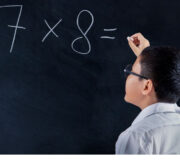What’s Asian-style Math? Why Schools Teach for Mastery
Asian style math mastery is taking elementary schools around the world by storm. Why is this, and what is it?
Why is it that East Asian countries, including China, consistently top the rankings in international math tests? Because they are taught better.
In the UK, the government was so convinced by the strengths of this style of teaching that they invested £41 million into the teaching of Asian-style Singapore and Shanghai math for their elementary age students.
The announcement raised many questions, among both experts and novices.
I’m lucky enough to have studied and practiced Singapore math (one of the most popular styles of Asian math) for several years and this post will give you an idea of the principles and benefits of Asian math and mastery math as I see them, and how you might be able to incorporate some of them into your own teaching.
What do we mean by Asian-style math
First, let’s clarify what we mean by Asian-style math. This typically includes Singapore, Shanghai and Hong Kong math, which originate from countries in Asia who have consistently been at the top of the leaderboard in international studies such as TIMSS and PISA.
There are clear differences between each country’s approach and education systems (which I will cover in a later blog post) but many of the principles and pedagogy remain the same.
All children can be mathematicians
This approach works off the premise that ‘all children can succeed in math’. This underpins everything and their math curriculum has been specifically designed to enable just that.
They also adopt the findings of educational psychologists and researchers including Skemp, Piaget, Bruner, Vygotsky and Dienes, to use a technique that focuses mathematics education on number sense and conceptual understanding before procedural fluency.
Concrete Representational Abstract – an Asian style math approach
Typically this is accessed through the CRA approach (Concrete – Representational – Abstract), where children are taught conceptually through problem-solving contexts, which are initially linked to real-life situations and real objects that they can manipulate.
Pupils start by being able to understand and relate to the questions in a ‘concrete’ method. As the student progresses in their understanding, the context is then represented in a ‘representational’ state (actual pictures of the objects at first, then later moving onto more abstract representations like bar models).
The final stage, ‘abstract’ refers to the more formal methods of calculations like column multiplication or the standard algorithm.
All these algorithms are linked closely to the conceptual understanding as opposed to taught as a set of procedures or rules to follow. Teaching this way allows children to go back to first principles if they were to ever forget the ‘rules’.
Furthermore, procedural fluency is developed and encouraged through investigating many different methods of solving a problem. Through this process, children develop a range of procedures and more importantly, are able to distinguish between, and use, more efficient methods when faced with a variety of problems.
If you’d like to know more, take a look at our math mastery toolkit.
Mixed ability teaching
Children studying in these South Asian regions are typically taught in mixed ability classes of up to 50 children, yet every child is expected to reach their potential and make good progress through the same activity.
You may wonder how this is possible. Surely the more advanced children will suffer from the lack of pace and challenge? How can depth and mastery be achieved? At first, I thought the same, but I was still thinking about teaching in the ‘traditional’ manner.
Not only are the teaching methods very different, but all activities are designed with ‘low threshold, high ceiling’ in mind – this means that everybody can access the learning, but where they take this learning is up to the individual’s own abilities and math skills.
Through teacher facilitation, expert questioning and peer discussions, all children are challenged at their level. This enables greater depth of understanding, allowing children themselves to disprove misconceptions that might arise.
As much of the learning happens through talk, mixed ability setting actually works better. More importantly, as all children work on the same task, children are not categorized as being of lower or higher ability.
Student confidence and the joy of math grows, they finally understand what is going on in math lessons!
Can Asian-style math work in US classrooms?
As mentioned, my own area of expertise is Singapore math – they primarily emphasize the use of teaching through textbooks – some may say following a ‘scheme’.
I hear your reservations, schemes should be used as a resource which we can dip into from time to time, not follow fully.
I would usually agree with you, but in this case, where the textbooks have been designed by a group of experts implementing, researching and refining over the course of many years, I’m happy to believe that they may have a better understanding of how children learn best and the order of which topics should be introduced to have the most impact.
Is it just about the Asian math textbooks?
So, let’s all just follow the textbooks and every child will succeed…It’s not quite as simple as that. But, provided the right teacher training and resources are in place, the textbooks really do work.
The concern at the rise in popularity in countries, including the US, is that schools may jump on board and buy the costly resources in a desire to boost progress and achievement. But if they don’t also invest in the substantial training for all staff that is required, they will find themselves back to square one!
Depth, mastery and Asian-style math
So finally let’s look at mastery, the longed-for state, where everything comes together: a student has conceptual and procedural fluency which enables him or her to link different areas of math to solve complex problems efficiently.
As the style of teaching focuses heavily on these areas, with slight variations, suddenly this becomes effortless for students and they can achieve mastery with greater ease.
So, all this considered, that’s why for me, it’s a no brainer…it is the way forward.
Looking for more guidance?
Schools who sign up for our one-to-one math tutoring are increasingly requesting that we use an Asian-math approach for their students as that’s what they’re used to.
I’ve recently been working with our tutors and colleagues to ensure that students are still taught with elements of the Asian approach in their one-to-one math lessons as well as back in class with their teacher.
This is just part of our process of continually reviewing our math curriculum, resources and the professional development for tutors at Third Space Learning to check that it is meeting the school’s current teaching needs.
Want to know more about a math mastery approach?
Read our blog post: The Beginner’s Guide To Becoming A Math Mastery Expert
Do you have students who need extra support in math?
Give your students more opportunities to consolidate learning and practice skills through personalized math tutoring with their own dedicated online math tutor.
Each student receives differentiated instruction designed to close their individual learning gaps, and scaffolded learning ensures every student learns at the right pace. Lessons are aligned with your state’s standards and assessments, plus you’ll receive regular reports every step of the way.
Personalized one-on-one math tutoring programs are available for:
– 2nd grade tutoring
– 3rd grade tutoring
– 4th grade tutoring
– 5th grade tutoring
– 6th grade tutoring
– 7th grade tutoring
– 8th grade tutoring
Why not learn more about how it works?
The content in this article was originally written by Math specialist & consultant Wendy Liu and has since been revised and adapted for US schools by elementary math teacher Christi Kulesza.




